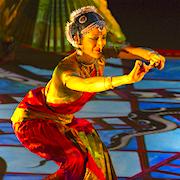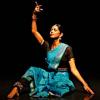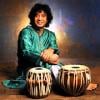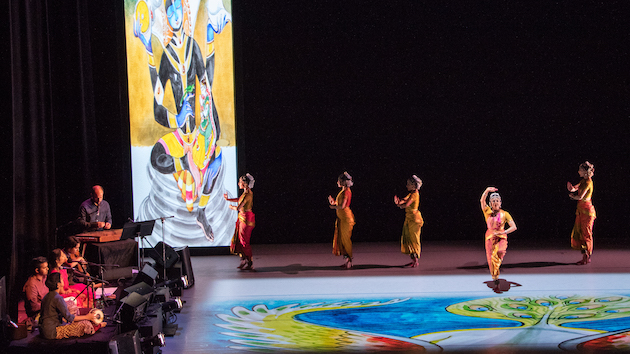
There are a lot of people in Aparna Ramaswamy’s “we.”
As co-artistic director of the Ragamala Dance Company, Ramaswamy most often uses the term to include her co-director and mother, Ranee Ramaswamy, when speaking about the company’s foundations and repertoire. Extending the plural pronoun, the parasol covers young Ramaswamy’s sister, Ashwini Ramaswamy, a dancer, choreographic associate, and Ragamala’s marketing director. Broaden the application of “we” to company dancers, collaborators, and their influences and the Minneapolis-based dance company rooted in classical South Indian Bharatanatyam embraces modern dance, classical ballet, American Sign Language, taiko drumming, medieval poetry, science, East-meets-West collaborative scores and themes, traditional Indian and contemporary American games, theater and literature, and more.
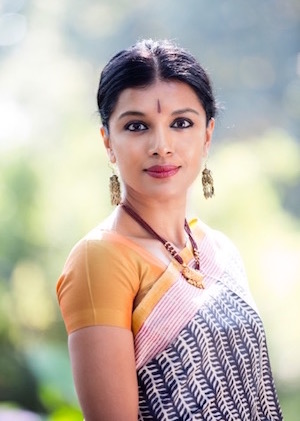
Ragamala brings Written in Water to Cal Performances, launching the cross-cultural Blurring Boundaries series with two performances December 2 and 3, at Zellerbach Playhouse in Berkeley. The work is performed to live music composed by Iraqi-American composer and trumpeter Amir ElSaffar and draws on Carnatic score “sketches” by Indian composer Prema Ramamurthy. The score blends American jazz, Iraqi maqam, and traditional Indian music. Program notes outline three movements, the first of which introduces Paramapadam, a 2nd-century Hindu game of morality that was brought to England in the 19th century as Snakes and Ladders, then renamed in American iterations as Chutes and Ladders. A second movement braids in Ksheerabthi Madanam, the Hindu myth about good and evil as represented by the churning of the seven seas. A final movement revolves around divine elements inspired by The Conference of the Birds, a Sufi poem that tells of birds traveling through seven valleys to find immortality.
“The original inspiration was Ranee’s memory of the board game,” says Ramaswamy in a phone interview while on tour in the Midwest. “Paramapadam was played once each year at a specific religious festival where families stayed up all night fasting. They played it to distract themselves from hunger, but also to share stories about family, mythology. Co-mingling the larger purpose with an all-ages game was fascinating to Ranee. She remembers falling asleep while her grandmother continued to play the game long into the night.”
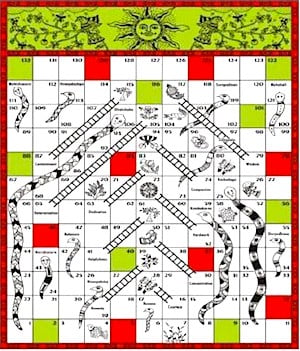
An image of the board game projected onto the stage frames the most active space for the dramatic facial expressions, meticulous hand gestures, circling, curving or elegantly held upright torsos and complex rhythmic footwork of the Bharatanatyam dance form. As the game board “breaks apart,” the dance moves into a narrative that initially blends the loneliness of a bird whose partner has been killed with the destruction and devastation of human warfare. Layered throughout and accumulatively by the full-length production’s end are physical representations and spacial patterns that reference snakes, water, pain, humanity, community, Hindu and Sufi beliefs and cultural traditions, and universal concepts of transcendence.
“We feel that different religions coming together still maintain their complexity. Hindu and Sufi philosophies brought into the same work have paradox, as well as similarities. What are we going resolve? What are we going to leave as things upon which we don’t all agree? The journey we all take as humans is shared. Our beliefs vary.”
It’s acceptable, maybe even desirable, to include two schools of thought and allow them to co-exist, Ramaswamy says.
Which doesn’t mean the path to understanding and completing Written in Water’s choreographic and narrative arc was a strictly linear process. After rehearsing and workshopping an early idea that the dance’s structure would be fluid, determined by chance with a roll of the die, “two-thousand attempts to fulfill the idea” changed their minds. “We had it so it was electronic and a dancer would perform set phrases when they landed on a certain square. That meant the dancers had to learn all of the parts and some nights, a dancer might not dance at all.”
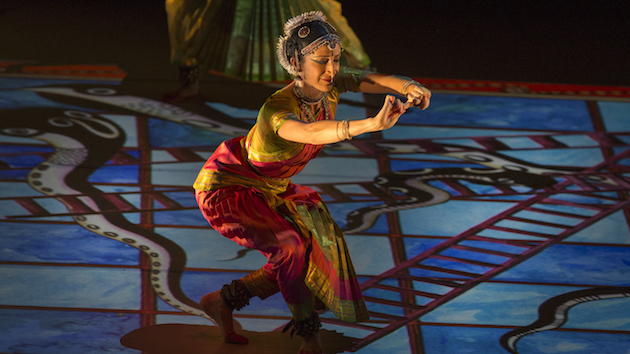
Although audiences found the spontaneity exciting, Ramaswamy says the dancers—caught in temporariness and unpredictability—lost the opportunity to become engrossed in the music and movement. Ultimately, deep immersion trumped daring improvisation and the choreography was set.
The score traveled a similar spiral staircase process from its base in Ramamurthy’s experiments with the melody, rhythms and length of traditional Carnatic compositions. Manipulating the music sketches to fit their needs, the choreographers invited ElSaffar to bring his trumpet to rehearsals and improvise. “Other parts, we’d talk to our singer (ElSaffar) and say we wanted it tragic and full and just with violin. Then he would sing to those notes. We worked with his maqam traditions to see what worked together. We considered what musical ideas should touch each other, what should never touch.” Choreographing to a third section composed entirely by ElSaffar, she says was like “building a building from nothing to everything.”
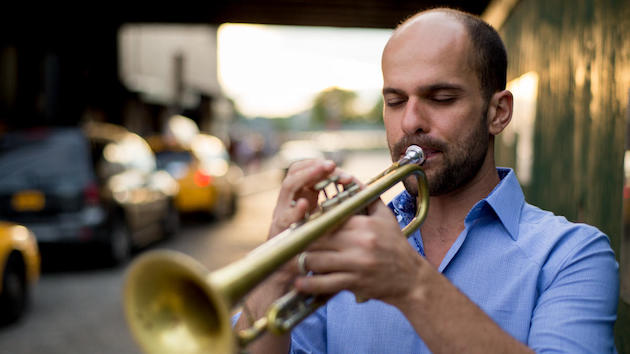
The work’s near-literary structures stretch from neatly shaped beginning-middle-end sections filled with constantly moving solos to intimate duets to the five-woman ensemble joined in a soulful, swirling journey. Seeking knowledge and enlightenment, they become a tribe, sometimes combative, at other times harmonious. Intimate “conversations” with gods or divine forces in final moments weave the dancers’ separate stories into unity.
Ramaswamy says a similar pinpoint-to-wide-angle kind of focus has been required to sustain a company for a quarter century. “Singleminded desire to share what we have and what we continue to learn about has led to our longevity. Indian dance is a dynamic form that can meet other literary and theatrical forms. It’s vivacious. That’s what has kept us going.” At the same time, the company to be relevant and to reach a broad contemporary audience has worked across styles and forms. “You must know what you are flexible about and what you will fight for—you must know that,” she says. “You must also have wonder about other forms. But if you open yourself up to that, it can be complex.”
A conversation she had with her mother earlier in the day addressed being a woman in a leadership position in the dance world. “Women have to ask for what they want; it will not be handed to them. I will always be nice, unless I’m pushed, but there’s a respectful way. Sometimes you have to ask and ask and ask, but you must do it. A woman must never be taught she cannot ask.”

